The document provides a comprehensive overview of arrays in C programming, detailing their definition, initialization, and usage for managing collections of data of the same type. It explains how to declare, access, and manipulate both one-dimensional and multidimensional arrays, along with coding examples demonstrating their applications. The document also emphasizes the importance of proper indexing to avoid common pitfalls like out-of-bounds errors.
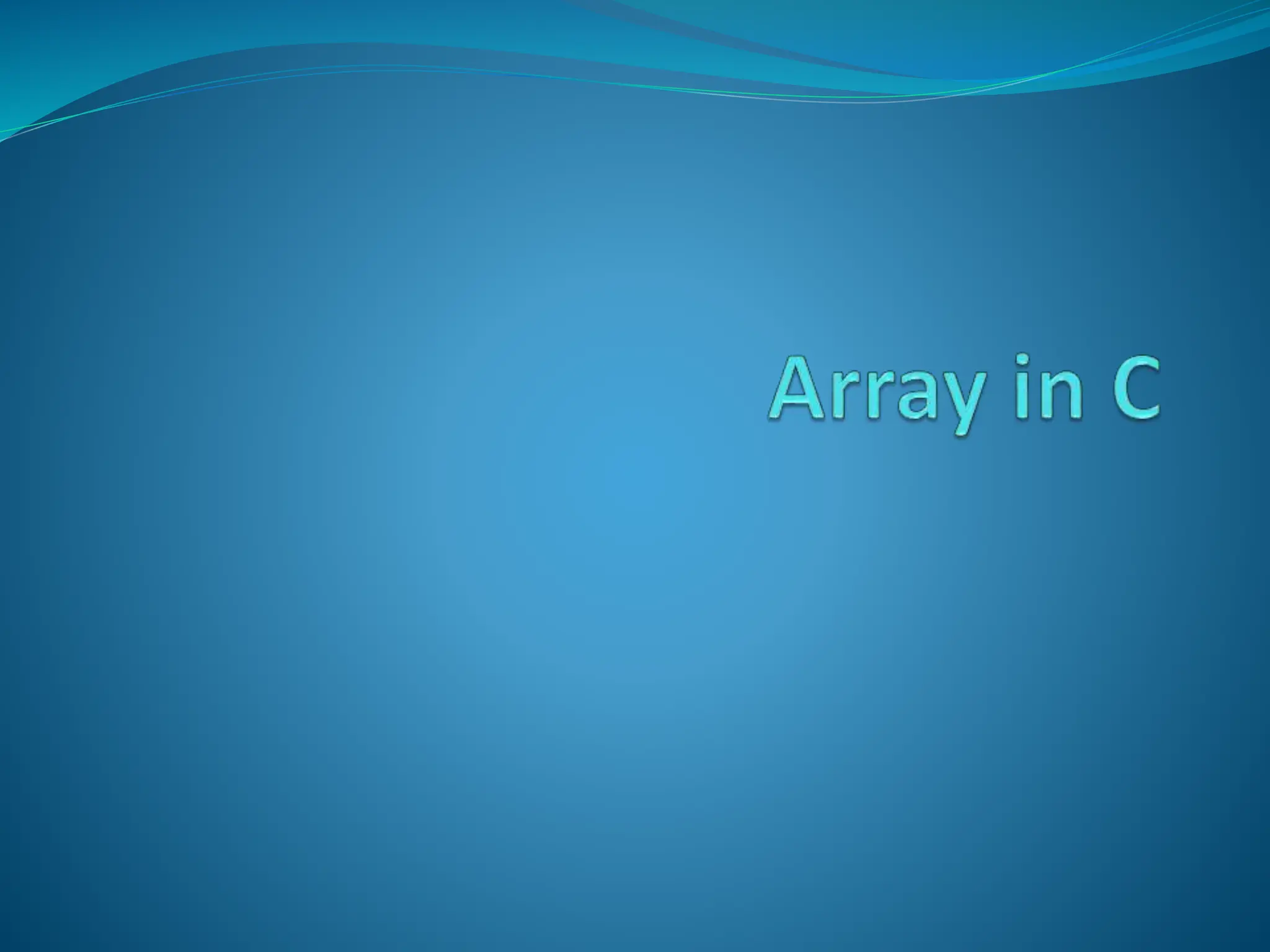
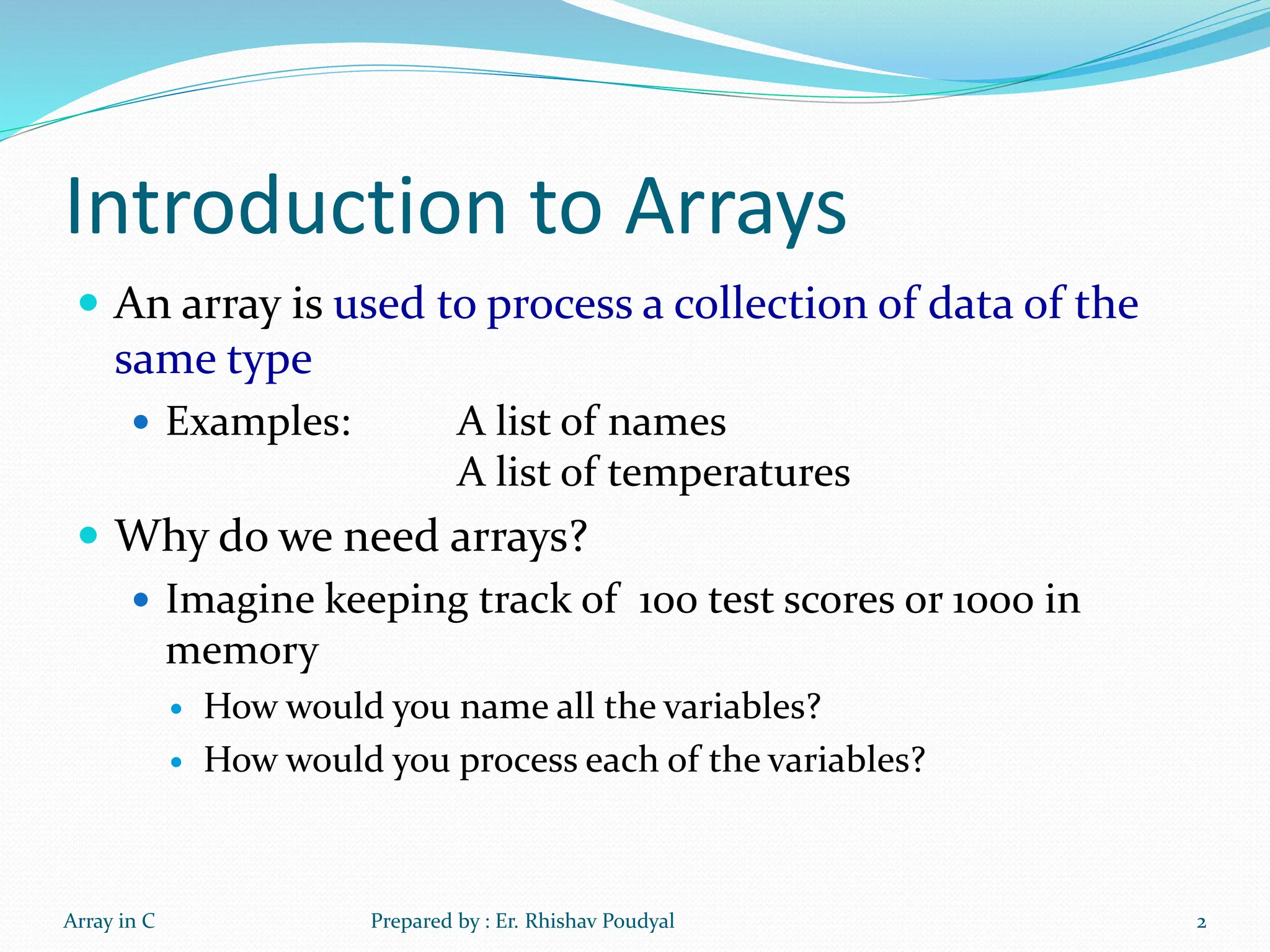
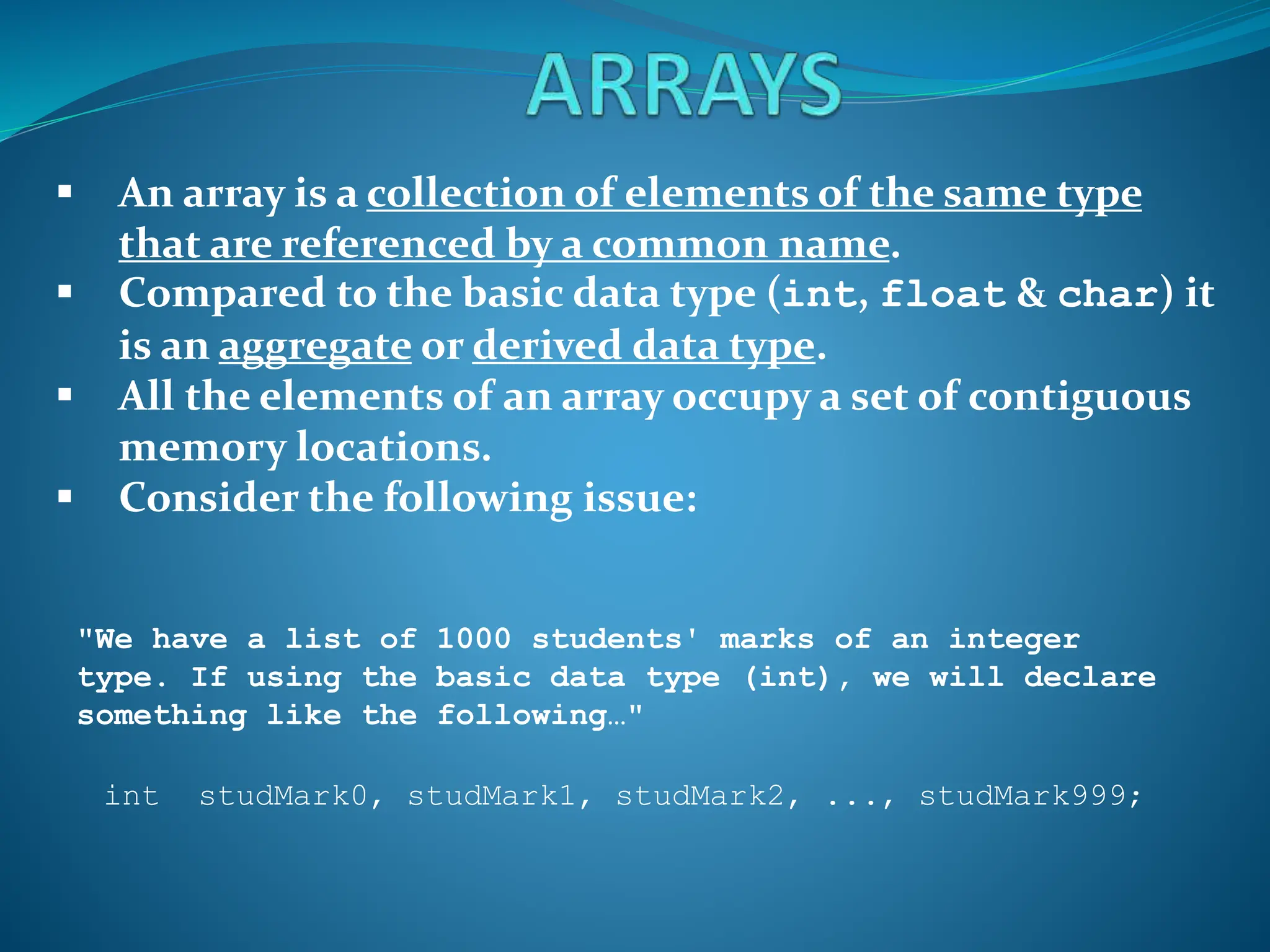
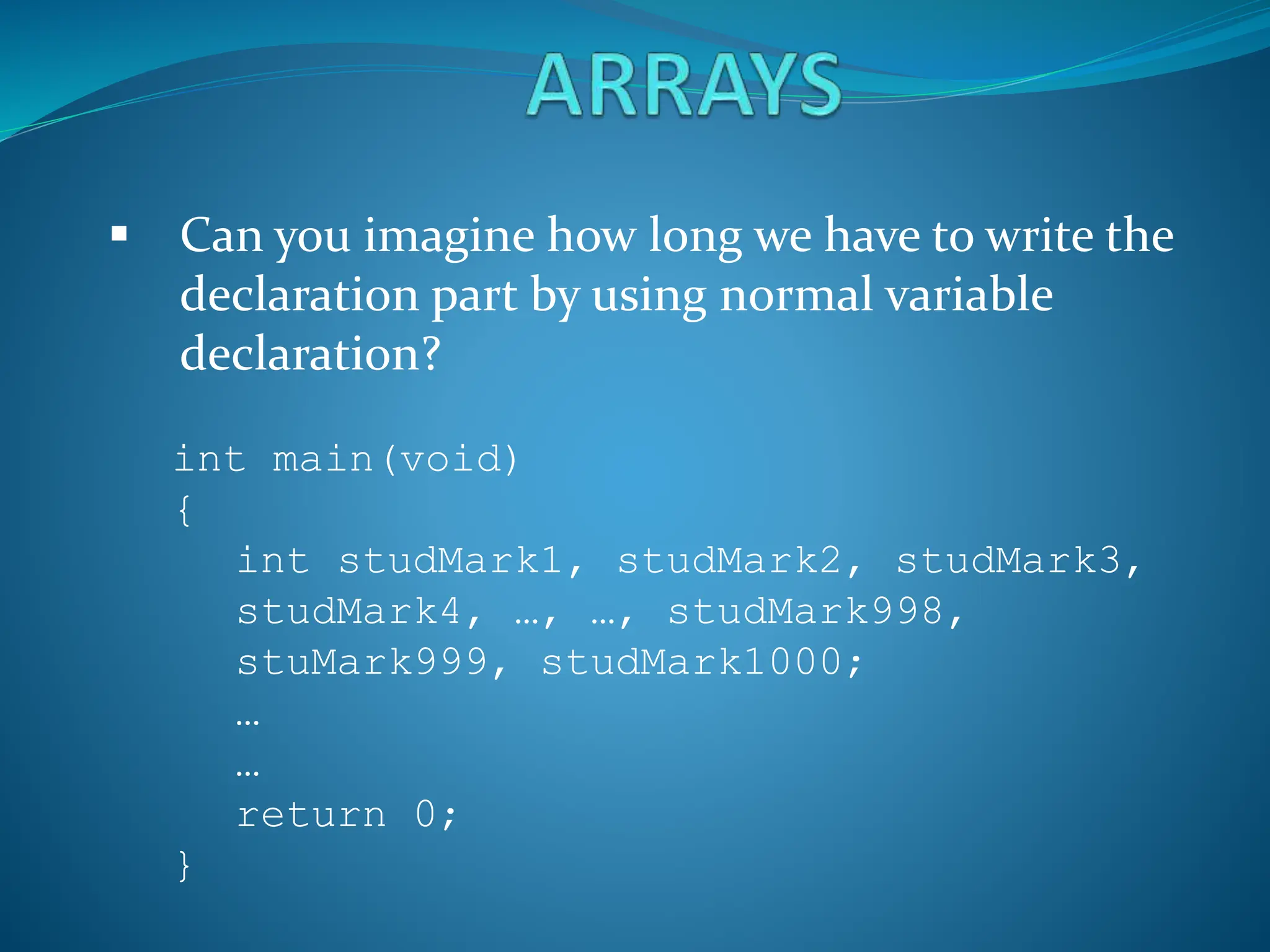
![Definition and Initialization Array is defined as the user defined (derived) data type which hold multiple data having same kind of data type. An array is defined using a declaration statement. data_type array_name[size]; allocates memory for size elements subscript of first element is 0 subscript of last element is size-1 size must be a constant 5 Array in C Prepared by : Er. Rhishav Poudyal](https://image.slidesharecdn.com/array-240708092845-bdb87368/75/Array-and-its-operation-in-C-programming-5-2048.jpg)
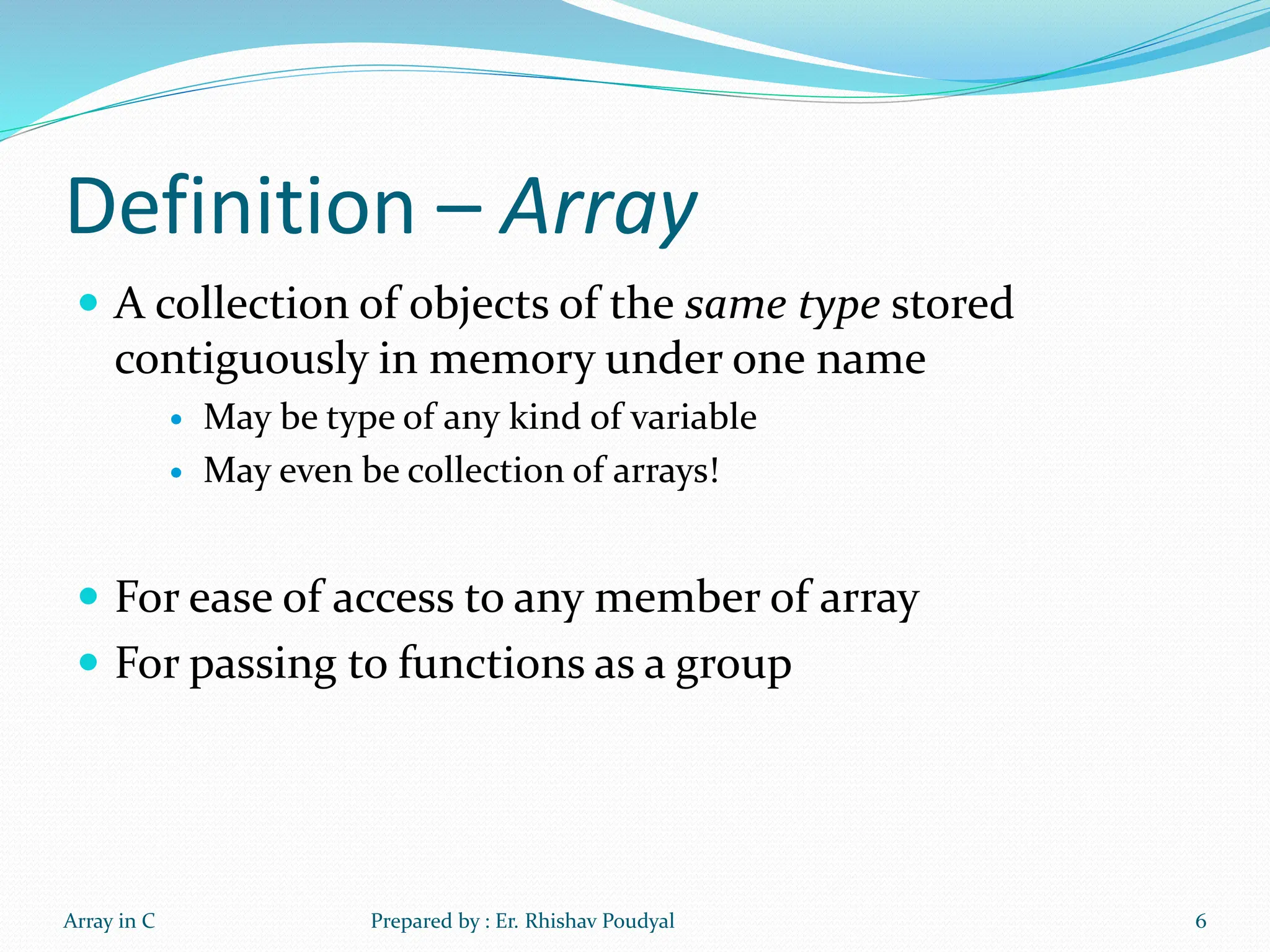
![Initializing Arrays To initialize an array when it is declared The values for the indexed variables are enclosed in braces and separated by commas Example: int children[3] = { 2, 12, 1 }; Is equivalent to: int children[3]; children[0] = 2; children[1] = 12; children[2] = 1; Array in C 7 Prepared by : Er. Rhishav Poudyal](https://image.slidesharecdn.com/array-240708092845-bdb87368/75/Array-and-its-operation-in-C-programming-7-2048.jpg)
![One-Dimensional Arrays Suppose, you need to store years of 100 cars. Will you define 100 variables? int y1, y2,…, y100; An array is an indexed data structure to represent several variables having the same data type: int y[100]; 8 y[0] y[1] y[2] … y[k-1] y[k] y[k+1] … y[98] y[99] Array in C Prepared by : Er. Rhishav Poudyal](https://image.slidesharecdn.com/array-240708092845-bdb87368/75/Array-and-its-operation-in-C-programming-8-2048.jpg)
![Arrays Array Group of consecutive memory locations Same name and type To refer to an element, specify Array name Position number Format: arrayname[ position number ] First element at position 0 n element array named c: c[ 0 ], c[ 1 ]...c[ n – 1 ] 9 Array in C Prepared by : Er. Rhishav Poudyal](https://image.slidesharecdn.com/array-240708092845-bdb87368/75/Array-and-its-operation-in-C-programming-9-2048.jpg)
![One-Dimensional Arrays (cont’d) An element of an array is accessed using the array name and an index or subscript, for example: y[5] which can be used like a variable In C, the subscripts always start with 0 and increment by 1, so y[5] is the sixth element The name of the array is the address of the first element and the subscript is the offset 10 y[0] y[1] y[2] … y[k-1] y[k] y[k+1] … y[98] y[99] Array in C Prepared by : Er. Rhishav Poudyal](https://image.slidesharecdn.com/array-240708092845-bdb87368/75/Array-and-its-operation-in-C-programming-10-2048.jpg)
![Arrays Array elements are like normal variables c[ 0 ] = 3; printf( "%d", c[ 0 ] ); Perform operations in subscript. If x equals 3 c[ 5 - 2 ] == c[ 3 ] == c[ x ] 11 Array in C Prepared by : Er. Rhishav Poudyal](https://image.slidesharecdn.com/array-240708092845-bdb87368/75/Array-and-its-operation-in-C-programming-11-2048.jpg)
![Declaring Arrays When declaring arrays, specify Name Type of array Number of elements arrayType arrayName[ numberOfElements ]; Examples: int c[ 10 ]; float myArray[ 3284 ]; Declaring multiple arrays of same type Format similar to regular variables Example: int b[ 100 ], x[ 27 ]; 12 Array in C Prepared by : Er. Rhishav Poudyal](https://image.slidesharecdn.com/array-240708092845-bdb87368/75/Array-and-its-operation-in-C-programming-12-2048.jpg)
![Examples (continued) int C[] An array of an unknown number of integers (allowable in a parameter of a function) C[0], C[1], …, C[max-1] int D[10][20] An array of ten rows, each of which is an array of twenty integers D[0][0], D[0][1], …, D[1][0], D[1][1], …, D[9][19] Not used so often as arrays of pointers 13 Array in C Prepared by : Er. Rhishav Poudyal](https://image.slidesharecdn.com/array-240708092845-bdb87368/75/Array-and-its-operation-in-C-programming-13-2048.jpg)
![Examples (continued) Initializers int n[ 5 ] = { 1, 2, 3, 4, 5 }; If not enough initializers, rightmost elements become 0 int n[ 5 ] = { 0 } All elements 0 If too many a syntax error is produced syntax error C arrays have no bounds checking If size omitted, initializers determine it int n[ ] = { 1, 2, 3, 4, 5 }; 5 initializers, therefore 5 element array 14 Array in C Prepared by : Er. Rhishav Poudyal](https://image.slidesharecdn.com/array-240708092845-bdb87368/75/Array-and-its-operation-in-C-programming-14-2048.jpg)
![Declaring an Array An array, named score, containing five variables of type int can be declared as int score[ 5 ]; This is like declaring 5 variables of type int: score[0], score[1], … , score[4] The value in brackets is called A subscript An index Array in C 15 Prepared by : Er. Rhishav Poudyal](https://image.slidesharecdn.com/array-240708092845-bdb87368/75/Array-and-its-operation-in-C-programming-15-2048.jpg)
![Assigning values to an array 16 For loops are often used to assign values to an array Example: int list[5], i; for(i=0; i<5; i++){ list[i] = i; } list[0] list[3] list[4] list[1] list[2] 0 1 2 3 4 list[0] list[1] list[2] list[3] list[4] OR for(i=0; i<=4; i++){ list[i] = i; } Array in C Prepared by : Er. Rhishav Poudyal](https://image.slidesharecdn.com/array-240708092845-bdb87368/75/Array-and-its-operation-in-C-programming-16-2048.jpg)
![Assigning values to an array 17 Give a for loop to assign the below values to list int list[5], i; for(i=0; i<5; i++){ list[i] = 4-i; } list[0] list[3] list[4] list[1] list[2] 4 3 2 1 0 Array in C Prepared by : Er. Rhishav Poudyal](https://image.slidesharecdn.com/array-240708092845-bdb87368/75/Array-and-its-operation-in-C-programming-17-2048.jpg)
![Array Element May be used wherever a variable of the same type may be used In an expression (including arguments) On left side of assignment Examples:– A[3] = x + y; x = y – A[3]; z = sin(A[i]) + cos(B[j]); 18 Array in C Prepared by : Er. Rhishav Poudyal](https://image.slidesharecdn.com/array-240708092845-bdb87368/75/Array-and-its-operation-in-C-programming-18-2048.jpg)
![Array Elements (continued) Generic form:– ArrayName[integer-expression] ArrayName[integer-expression] [integer-expression] Same type as the underlying type of the array Definition:– Array Index – the expression between the square brackets 19 Array in C Prepared by : Er. Rhishav Poudyal](https://image.slidesharecdn.com/array-240708092845-bdb87368/75/Array-and-its-operation-in-C-programming-19-2048.jpg)
![Array Elements (continued) Array elements are commonly used in loops E.g., for(i=0; i < max; i++) A[i] = i*i; sum = 0; for(j=0; j < max; j++) sum += B[j]; 20 Array in C Prepared by : Er. Rhishav Poudyal](https://image.slidesharecdn.com/array-240708092845-bdb87368/75/Array-and-its-operation-in-C-programming-20-2048.jpg)
![Array Initialization int A[5] = {2, 4, 8, 16, 32}; Static or automatic int B[20] = {2, 4, 8, 16, 32}; Unspecified elements are guaranteed to be zero int C[4] = {2, 4, 8, 16, 32}; Error — compiler detects too many initial values int D[5] = {2*n, 4*n, 8*n, 16*n, 32*n}; Automatically only; array initialized to expressions 21 Array in C Prepared by : Er. Rhishav Poudyal](https://image.slidesharecdn.com/array-240708092845-bdb87368/75/Array-and-its-operation-in-C-programming-21-2048.jpg)
![Implicit Array Size Determination int days[] = {31, 28, 31, 30, 31, 30, 31, 31, 30, 31, 30, 31}; Array is created with as many elements as initial values In this case, 12 elements Values must be compile-time constants (for static arrays) Values may be run-time expressions (for automatic arrays) 22 Array in C Prepared by : Er. Rhishav Poudyal](https://image.slidesharecdn.com/array-240708092845-bdb87368/75/Array-and-its-operation-in-C-programming-22-2048.jpg)
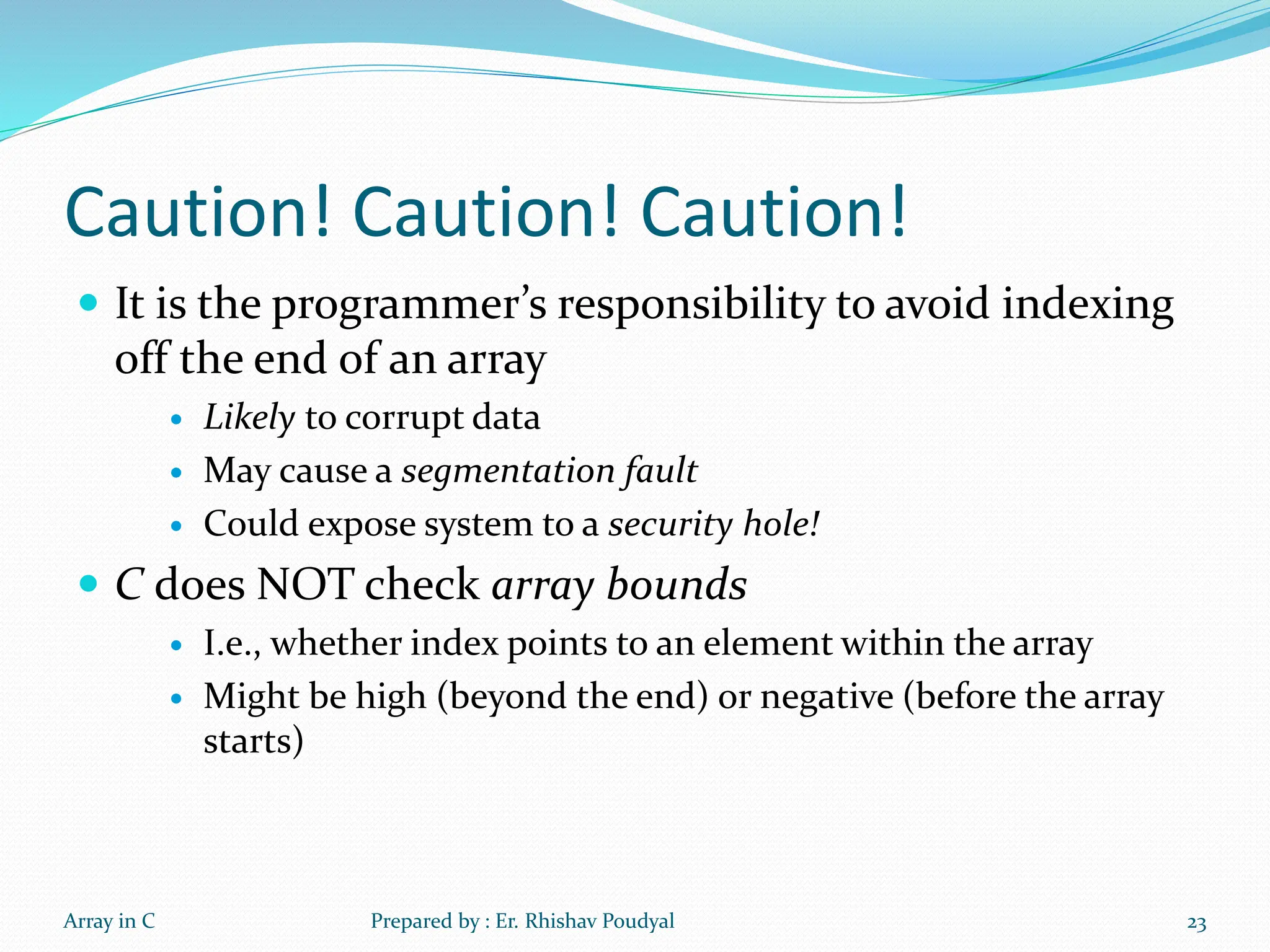
![Initializing Arrays Arrays can be initialized at the time they are declared. Examples: double taxrate[3] ={0.15, 0.25, 0.3}; char list[5] = {‘h’, ’e’, ’l’, ’l’, ’o’}; double vector[100] = {0.0}; /* assigns zero to all 100 elements */ int s[] = {5,0,-5}; /*the size of s is 3*/ 24 Array in C Prepared by : Er. Rhishav Poudyal](https://image.slidesharecdn.com/array-240708092845-bdb87368/75/Array-and-its-operation-in-C-programming-24-2048.jpg)
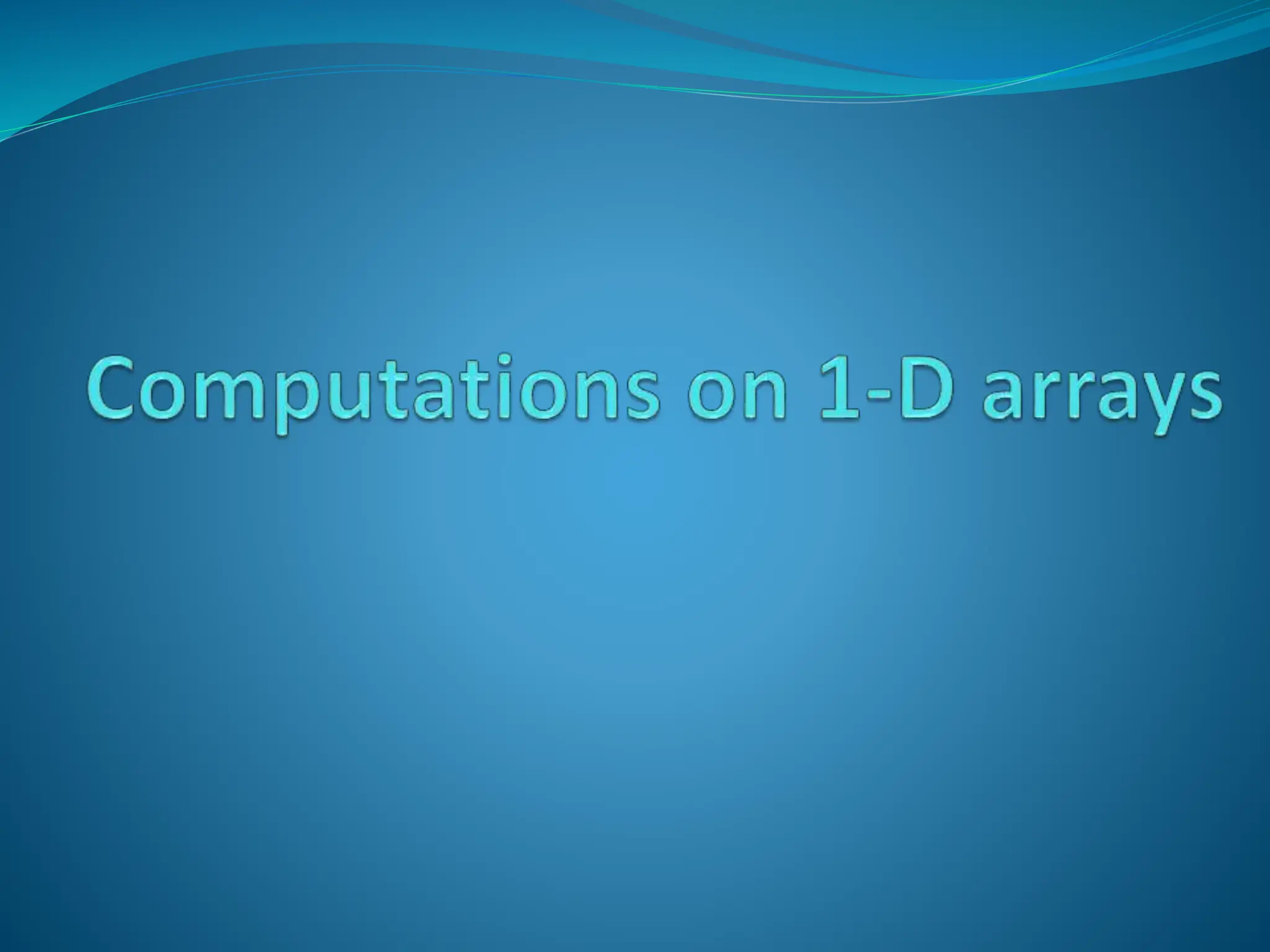
![Find Maximum Find maximum value in data array int data[100], max, i; for (i=0; i<100; i++) scanf(“%d”,&data[i]); max = data[0]; for (i=1; i<100; i++){ if (data[i] > max) max = data[i]; } printf("Max = %dn",max); 26 Array in C Prepared by : Er. Rhishav Poudyal](https://image.slidesharecdn.com/array-240708092845-bdb87368/75/Array-and-its-operation-in-C-programming-26-2048.jpg)
![Find average 27 Find average of values in data array int data[100], sum, i, avg; for (i=0; i<100; i++) data[i] = rand_int(10,109); sum = 0; for (i=0; i<100; i++) { sum = sum + data[i]; } avg = (double)sum/100; printf(“Avg = %lfn", avg); Array in C Prepared by : Er. Rhishav Poudyal](https://image.slidesharecdn.com/array-240708092845-bdb87368/75/Array-and-its-operation-in-C-programming-27-2048.jpg)
![Number of elements greater than average After finding the average as shown in previous slide, use the following code 28 count = 0; for (i=0; i<100; i++) { if (data[i] > avg) count++; } printf(“%d elements are greater than avg”, count); Array in C Prepared by : Er. Rhishav Poudyal](https://image.slidesharecdn.com/array-240708092845-bdb87368/75/Array-and-its-operation-in-C-programming-28-2048.jpg)
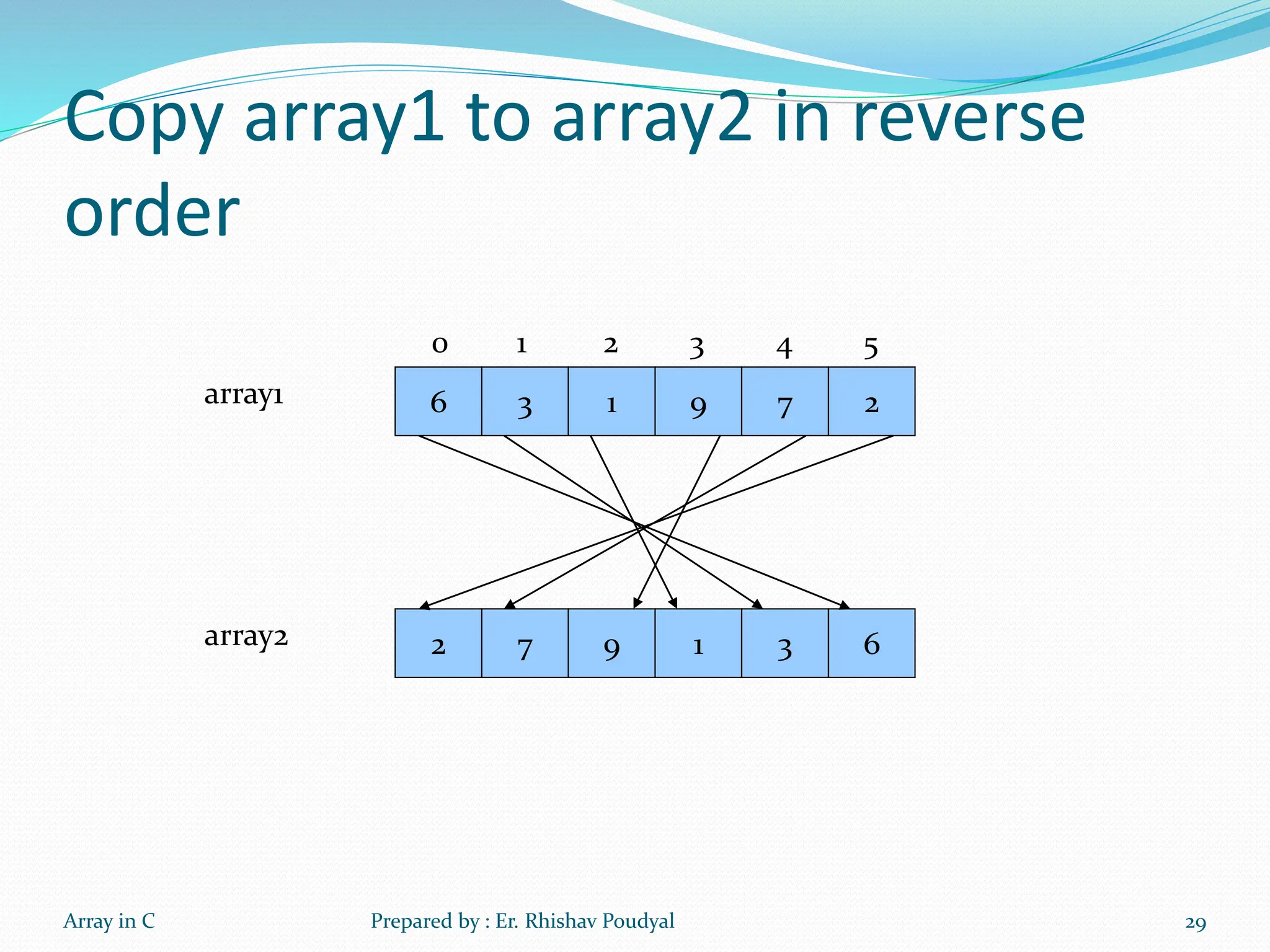
![What are Multidimensional Arrays A multidimensional array is treated as an array of arrays. Let a be a k-dimensional array; the elements of a can be accessed using the following syntax: a [ i1 ] [ i2 ]…[ ik ] where i1, i2, ….., ik Array in C 30 Prepared by : Er. Rhishav Poudyal](https://image.slidesharecdn.com/array-240708092845-bdb87368/75/Array-and-its-operation-in-C-programming-30-2048.jpg)
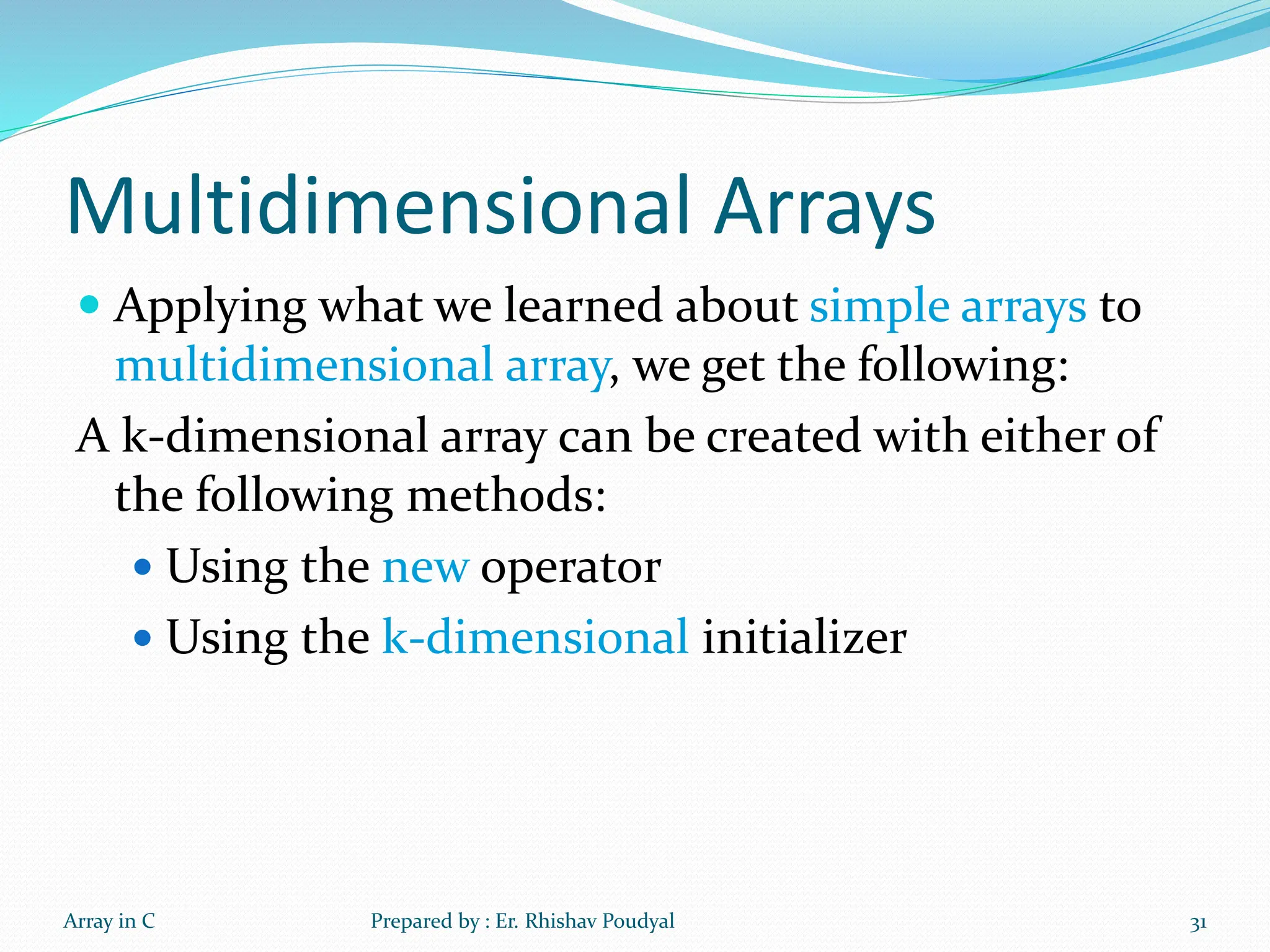
![Creating k-dimensional Array Using the new operator new Type [ n1] [n2]…[nk] Size of each dimension is n1, n2, …,nk, respectively. All the elements in the array are initialized to default initial values based on the type of the elements Using k-dimensional array initializer {I1, I2, ...., Ik} where each I1, I2, ...., Ik is a (k-1)- dimensional array initializer. Array in C 32 Prepared by : Er. Rhishav Poudyal](https://image.slidesharecdn.com/array-240708092845-bdb87368/75/Array-and-its-operation-in-C-programming-32-2048.jpg)
![Examples… Using the new operator, the following example is of creating and initializing a two-dimensional array. double mat1[4 ][5 ] This creates a 4 x 5 two- dimensional array. All elements are initialized to 0.0. Using k-dimensional array initializer, the following example is of creating and initializing a two-dimensional array. int mat2[ ] [ ] = {{1, 2, 3}, {4, 5, 6}}; This creates a 2 x 3 two-dimensional array. The elements are initialized as: mat2[0][0]=1 mat2[1][0]= 4 mat2[0][1]=2 mat2[1][1]= 5 mat2[0][2]=3 mat2[1][2]= 6 Array in C 33 Prepared by : Er. Rhishav Poudyal](https://image.slidesharecdn.com/array-240708092845-bdb87368/75/Array-and-its-operation-in-C-programming-33-2048.jpg)
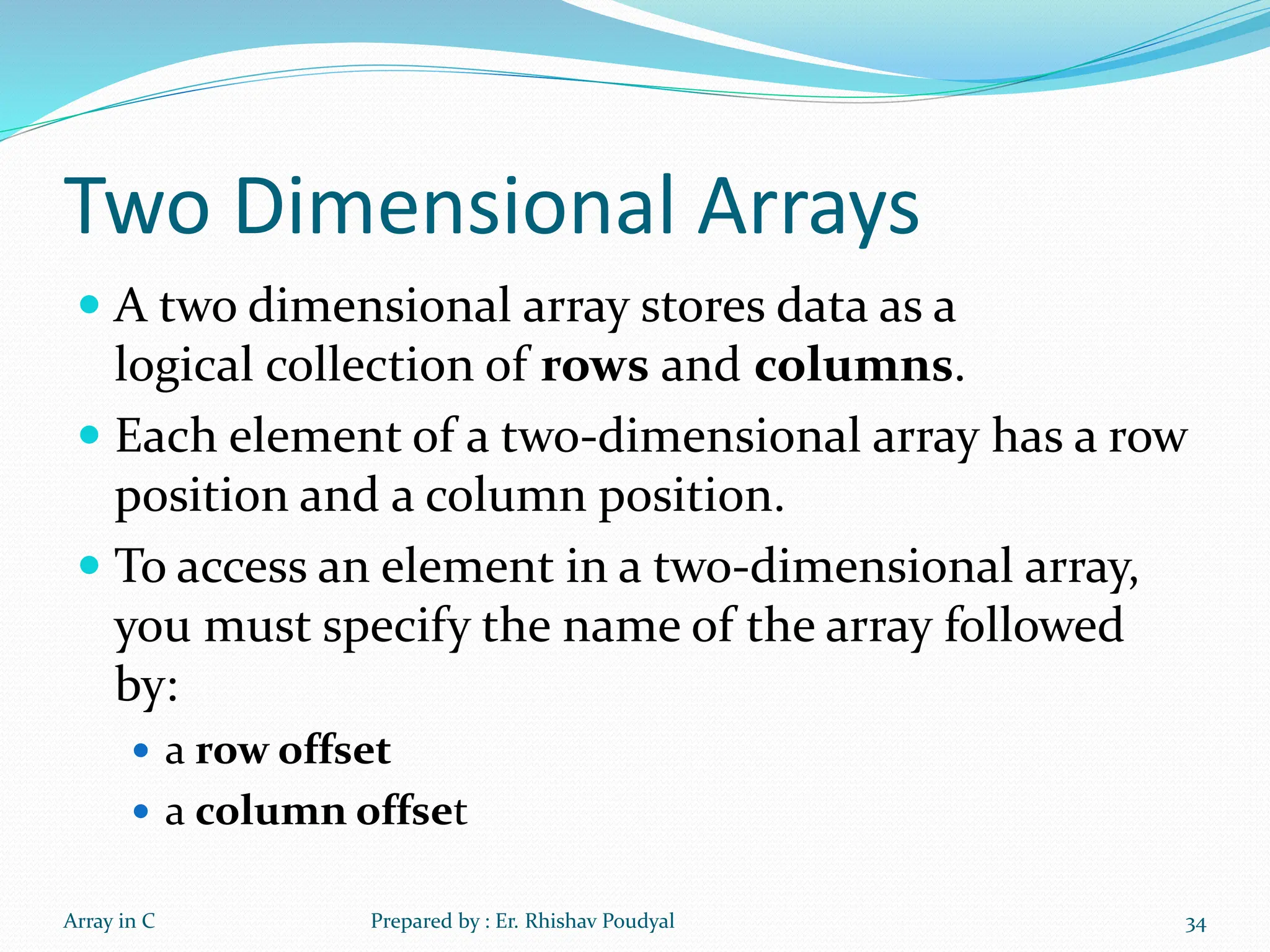
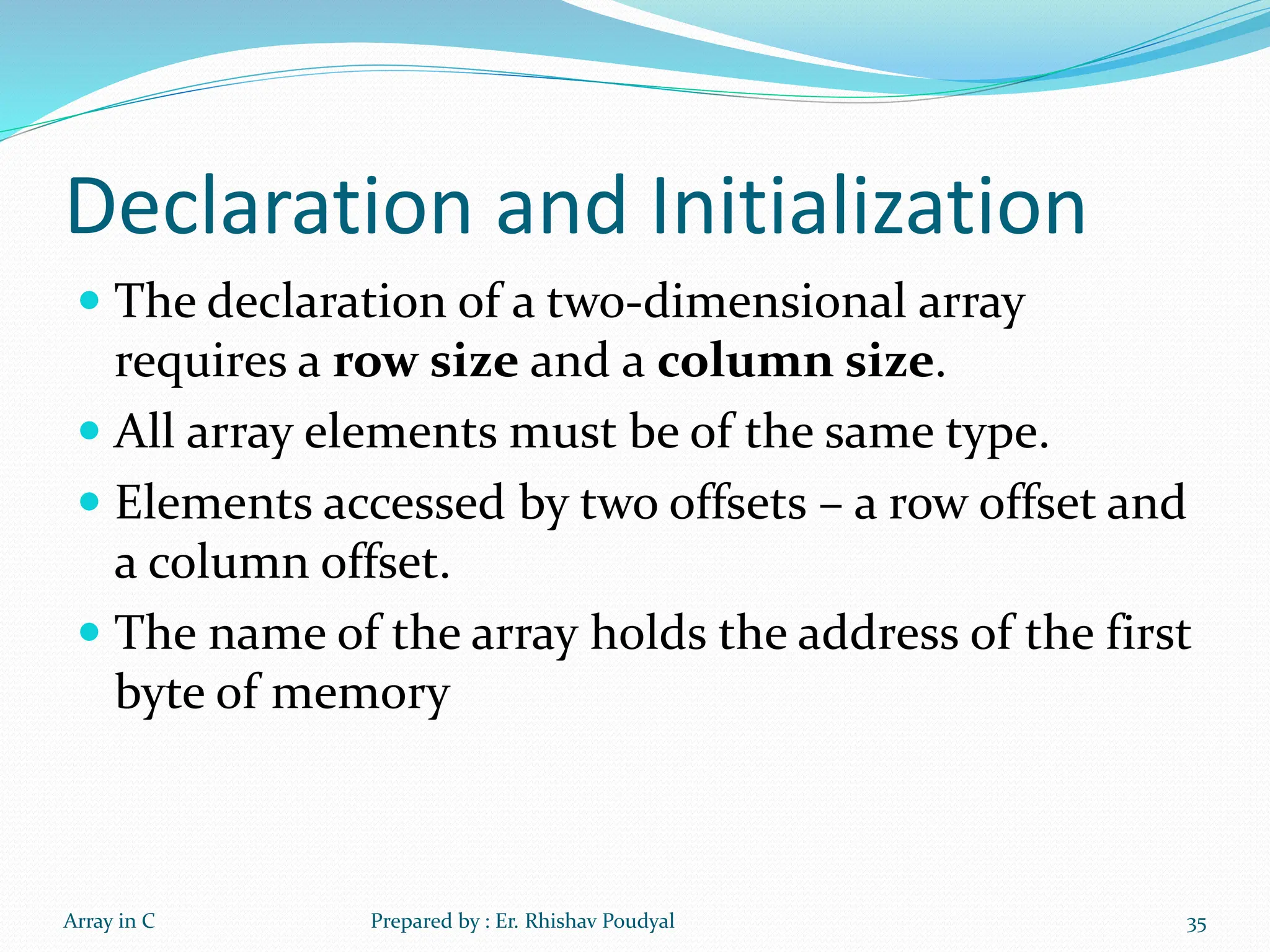
![Example //Declaration int data[2][3]; Memory Snapshot ? ? ? ? ? ? data Array in C 36 Prepared by : Er. Rhishav Poudyal](https://image.slidesharecdn.com/array-240708092845-bdb87368/75/Array-and-its-operation-in-C-programming-36-2048.jpg)
![Example //Declaration int data[2][3]; ? ? ? ? ? ? row 0 row 1 col 0 col 1 col 2 row/column form: Array in C 37 Prepared by : Er. Rhishav Poudyal](https://image.slidesharecdn.com/array-240708092845-bdb87368/75/Array-and-its-operation-in-C-programming-37-2048.jpg)
![2D Array Definition Syntax Syntax: data_type identifier[ [row_size] ][column_size] [= initialization_list ]; //row_size and column_size must be integer constants Examples int data[2][5]; //allocates consecutive memory for 10 integer values double t[2][2] = {{3.0,5.0},{2.1,7.2}}; //allocates and initializes Array in C 38 Prepared by : Er. Rhishav Poudyal](https://image.slidesharecdn.com/array-240708092845-bdb87368/75/Array-and-its-operation-in-C-programming-38-2048.jpg)
![Initialization Examples int temp[4][3] = {50, 70, 60, 48, 75, 62, 51, 69, 60, 52, 78, 63}; int temp[4][3] = {{50, 70, 60}, {48, 75, 62}, {51, 69, 60}, {52, 78, 63}}; int temp[][3] = {{50, 70, 60}, {48, 75, 62}, {51, 69, 60}, {52, 78, 63}}; int temp[][3] = {50, 70, 60, 48, 75, 62, 51, 69, 60, 52, 78, 63}; Array in C 39 Prepared by : Er. Rhishav Poudyal](https://image.slidesharecdn.com/array-240708092845-bdb87368/75/Array-and-its-operation-in-C-programming-39-2048.jpg)
![Example: Input Nested for loops are often used when inputting and assigning values to a two-dimensional array. Nested loops are generally useful for getting around the 2D arrays… //Declaration double table[RSIZE][CSIZE]; for (int i=0; i<RSIZE; ++i) //every row for (int j=0; j<CSIZE; ++j )//every col scanf(“%lf”,&table[i][j]; Array in C 40 Prepared by : Er. Rhishav Poudyal](https://image.slidesharecdn.com/array-240708092845-bdb87368/75/Array-and-its-operation-in-C-programming-40-2048.jpg)
![Example: Assignment //Declaration const int RSIZE(3),CSIZE(2); double v[RSIZE][CSIZE]; for (int i=0; i<RSIZE; ++i) //every row for (int j=0; j<CSIZE; ++j )//every col v[i][j] = i+j; 0 1 1 2 2 3 V Array in C 41 Prepared by : Er. Rhishav Poudyal](https://image.slidesharecdn.com/array-240708092845-bdb87368/75/Array-and-its-operation-in-C-programming-41-2048.jpg)
![Example: Computations Compute the average value of an array with n rows and m columns. double sum(0), average; for (int i=0; i<n; ++i)//every row for (int j=0; j<m; ++j )//every col sum += array[i][j]; average = sum / (n*m); Array in C 42 Prepared by : Er. Rhishav Poudyal](https://image.slidesharecdn.com/array-240708092845-bdb87368/75/Array-and-its-operation-in-C-programming-42-2048.jpg)
![Example: Computations Compute the average value of the nth row of a 2D array with r rows and c columns. double sum(0), rowAverage; for (int j=0; j<c; ++j ) //every col sum += array[n][j]; average = sum / c; Array in C 43 Prepared by : Er. Rhishav Poudyal](https://image.slidesharecdn.com/array-240708092845-bdb87368/75/Array-and-its-operation-in-C-programming-43-2048.jpg)
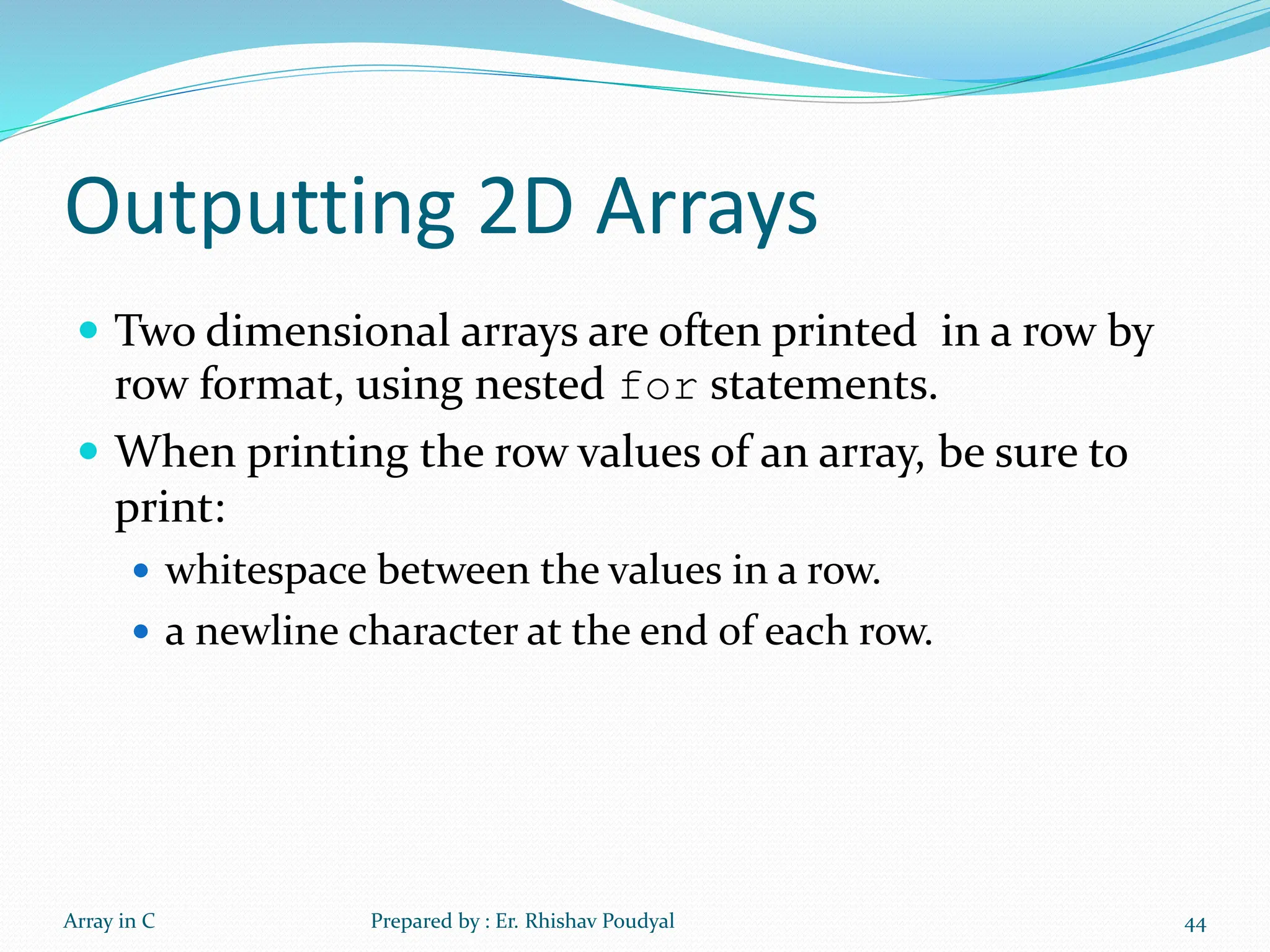
![Example: Printing for (int i=0; i<n; ++i) {//every row { for (int j=0; j<m; ++j )//every col printf(“%d”,array[i][j]); } Array in C 45 Prepared by : Er. Rhishav Poudyal](https://image.slidesharecdn.com/array-240708092845-bdb87368/75/Array-and-its-operation-in-C-programming-45-2048.jpg)
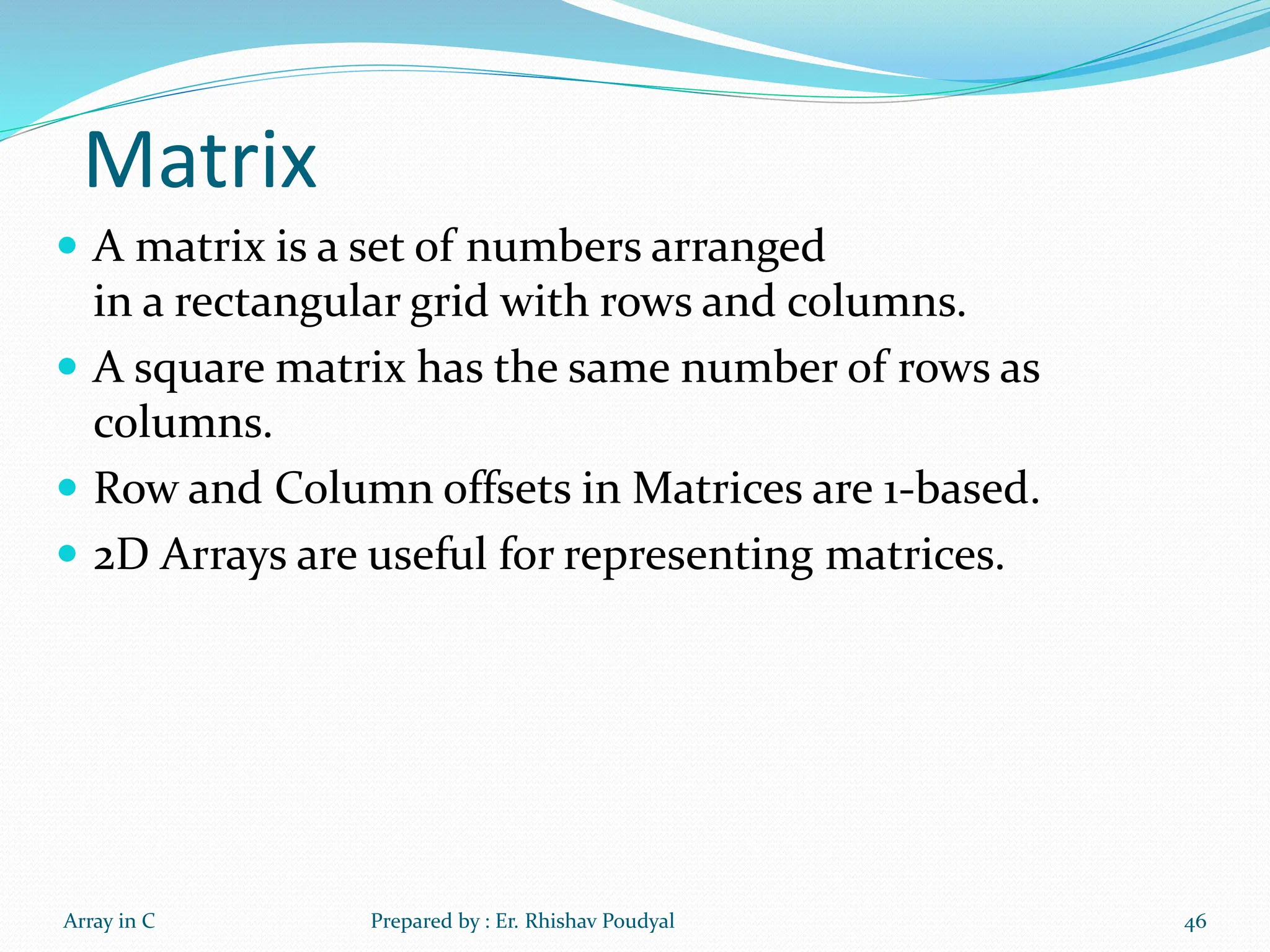
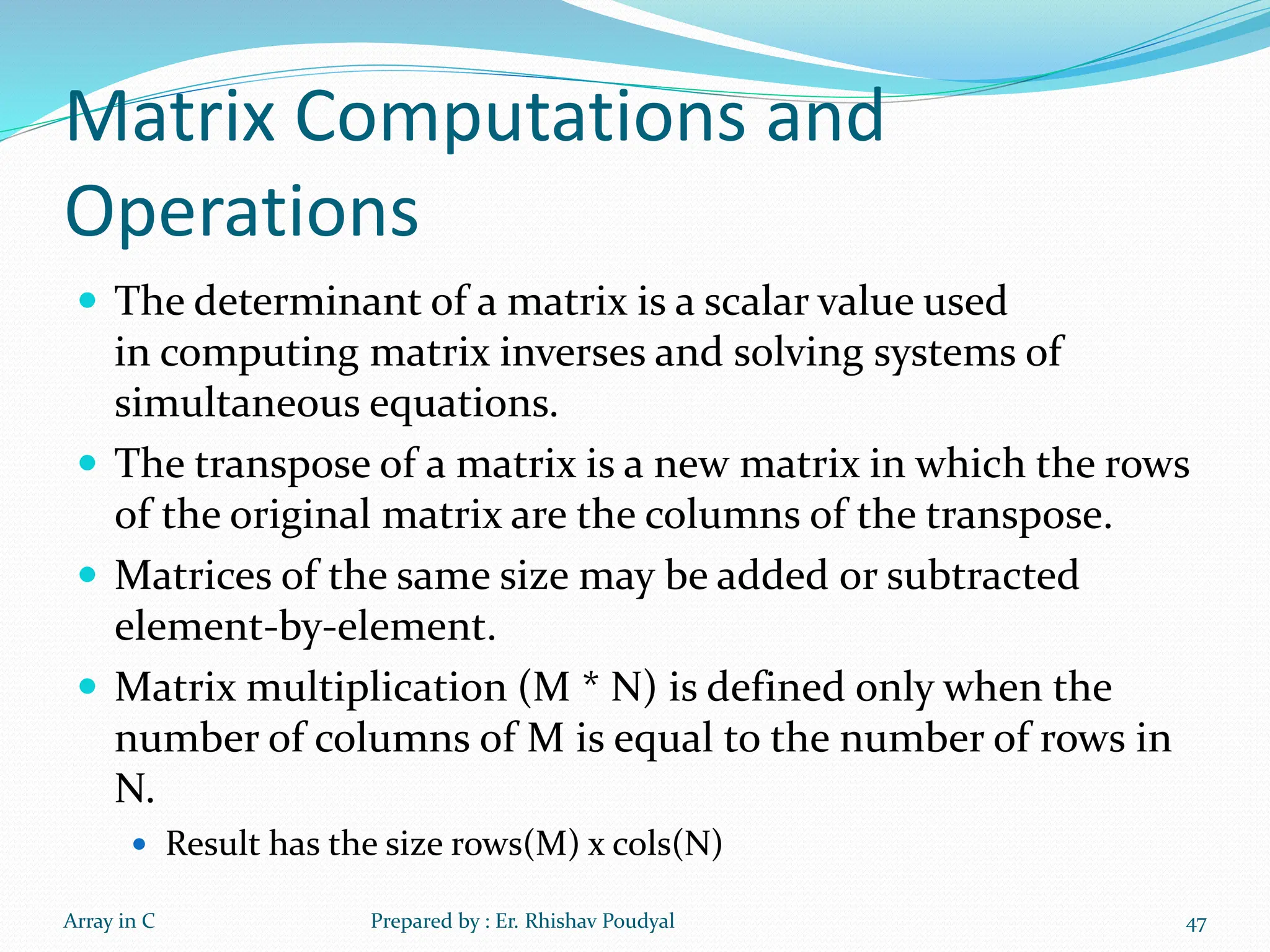
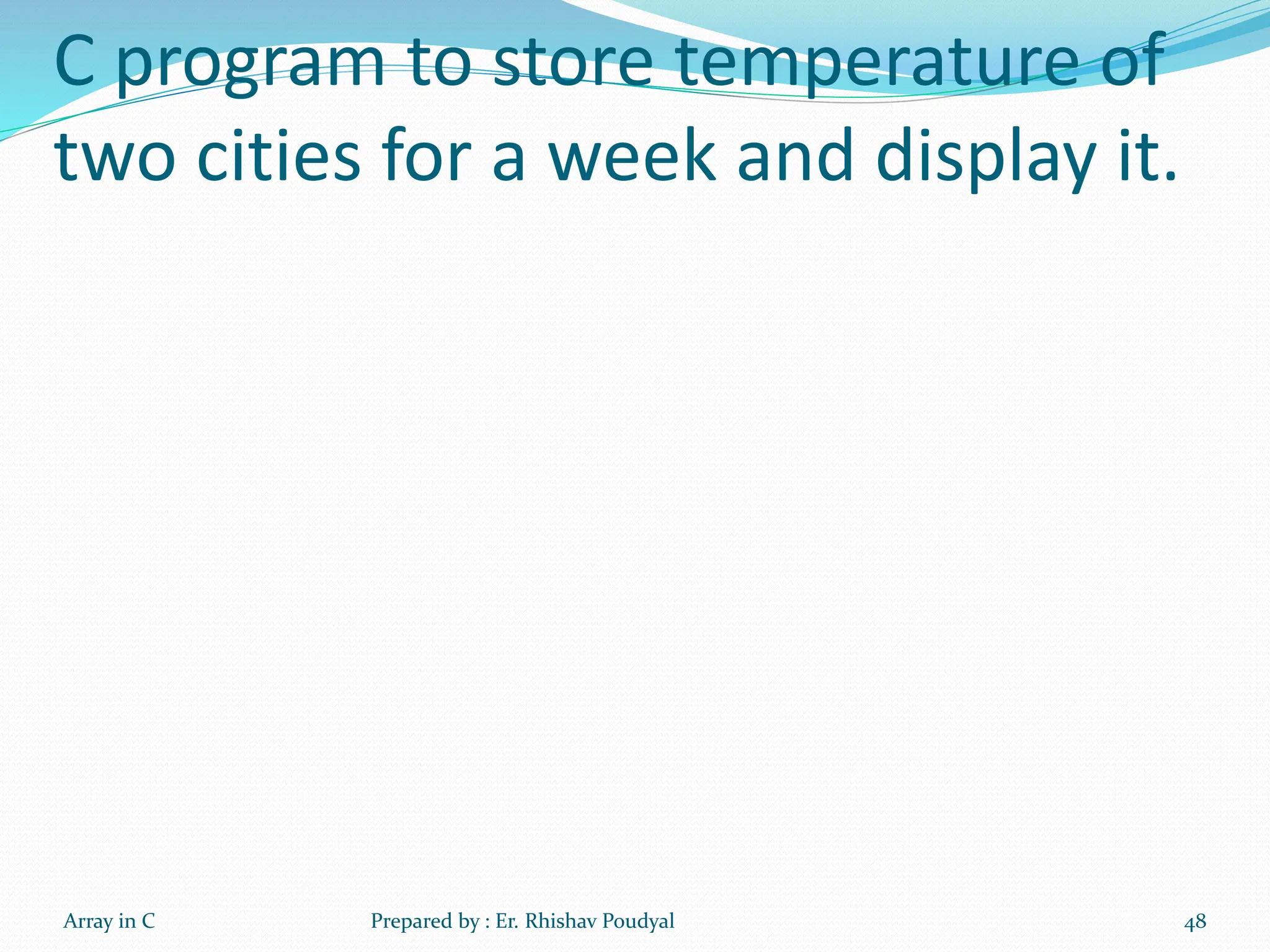
![49 const int CITY = 2; const int WEEK = 7; void main() { int temperature[CITY][WEEK]; for (int i = 0; i < CITY; ++i) { for(int j = 0; j < WEEK; ++j) { printf("City %d, Day %d: ", i+1, j+1); scanf("%d", &temperature[i][j]); } } printf("nDisplaying values: nn"); for (int i = 0; i < CITY; ++i) { for(int j = 0; j < WEEK; ++j) { printf("City %d, Day %d = %dn", i+1, j+1, temperature[i][j]); } } } Array in C Prepared by : Er. Rhishav Poudyal](https://image.slidesharecdn.com/array-240708092845-bdb87368/75/Array-and-its-operation-in-C-programming-49-2048.jpg)
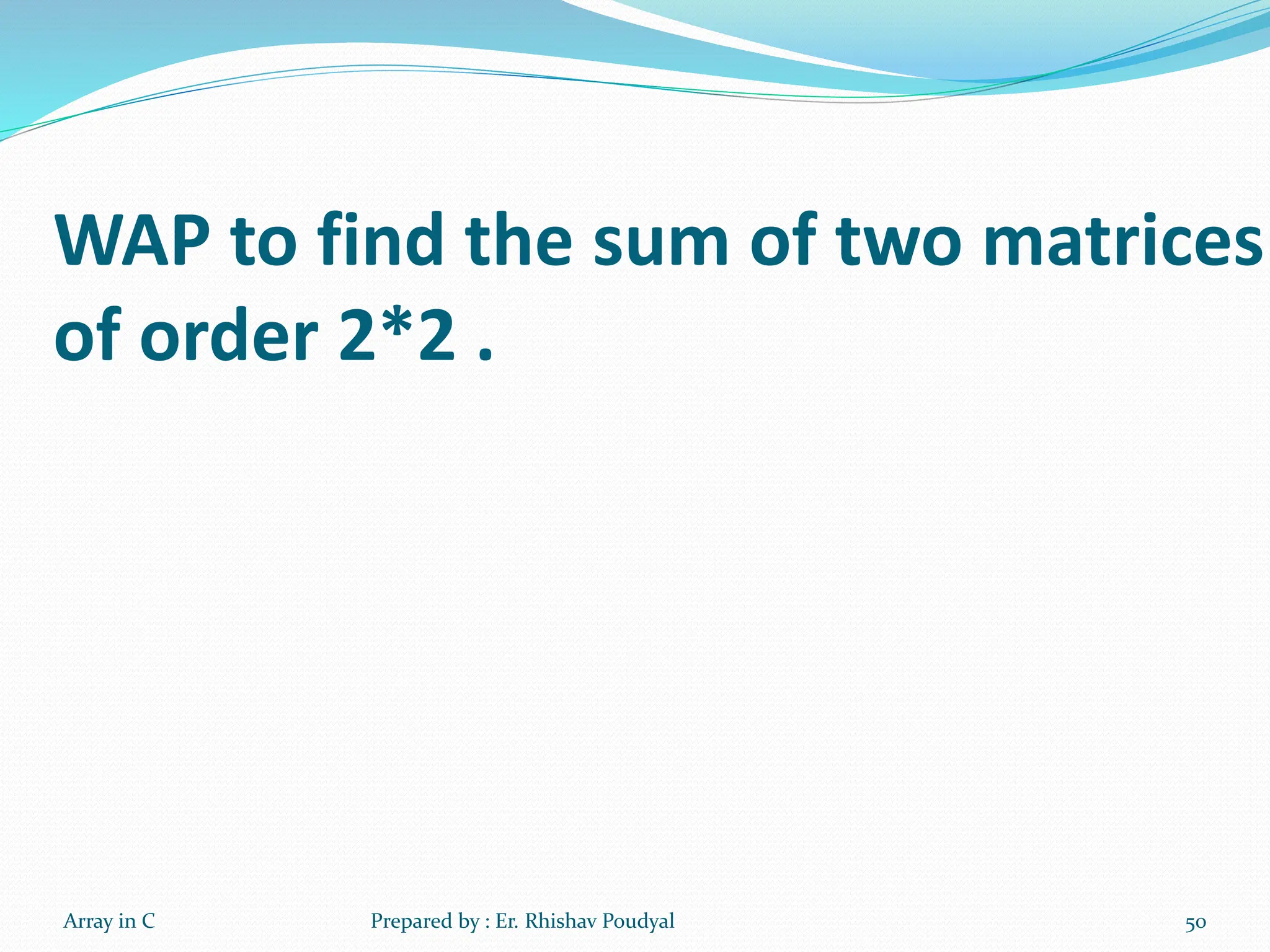
![51 #include <stdio.h> int main() { float a[2][2], b[2][2], c[2][2]; int i, j; printf("Enter elements of 1st matrixn"); for(i=0; i<2; ++i) for(j=0; j<2; ++j) { printf("Enter a%d%d: ", i+1, j+1); scanf("%f", &a[i][j]); } printf("Enter elements of 2nd matrixn"); for(i=0; i<2; ++i) for(j=0; j<2; ++j) { printf("Enter b%d%d: ", i+1, j+1); scanf("%f", &b[i][j]); } Array in C Prepared by : Er. Rhishav Poudyal](https://image.slidesharecdn.com/array-240708092845-bdb87368/75/Array-and-its-operation-in-C-programming-51-2048.jpg)
![52 // adding corresponding elements of two arrays for(i=0; i<2; ++i) for(j=0; j<2; ++j) { c[i][j] = a[i][j] + b[i][j]; } // Displaying the sum printf("nSum Of Matrix:"); for(i=0; i<2; ++i) for(j=0; j<2; ++j) { printf("%.1ft", c[i][j]); if(j==1) printf("n"); } return 0; } Array in C Prepared by : Er. Rhishav Poudyal](https://image.slidesharecdn.com/array-240708092845-bdb87368/75/Array-and-its-operation-in-C-programming-52-2048.jpg)

![54 #include <stdio.h> void main() { int a[10][10], transpose[10][10], row, col, i, j; printf("Enter rows and columns of matrix: "); scanf("%d %d", &row, &col); printf("nEnter elements of matrix:n"); for(i=0; i<row; ++i) for(j=0; j<col; ++j) { printf("Enter element a%d%d: ",i+1, j+1); scanf("%d", &a[i][j]); } Array in C Prepared by : Er. Rhishav Poudyal](https://image.slidesharecdn.com/array-240708092845-bdb87368/75/Array-and-its-operation-in-C-programming-54-2048.jpg)
![55 // Finding the transpose of matrix a for(i=0; i<row; ++i) for(j=0; j<col; ++j) { transpose[j][i] = a[i][j]; } // Displaying the transpose of matrix a printf("nTranspose of Matrix:n"); for(i=0; i<col; ++i) for(j=0; j<row; ++j) { printf("%d ",transpose[i][j]); if(j==r-1) printf("nn"); } } Array in C Prepared by : Er. Rhishav Poudyal](https://image.slidesharecdn.com/array-240708092845-bdb87368/75/Array-and-its-operation-in-C-programming-55-2048.jpg)
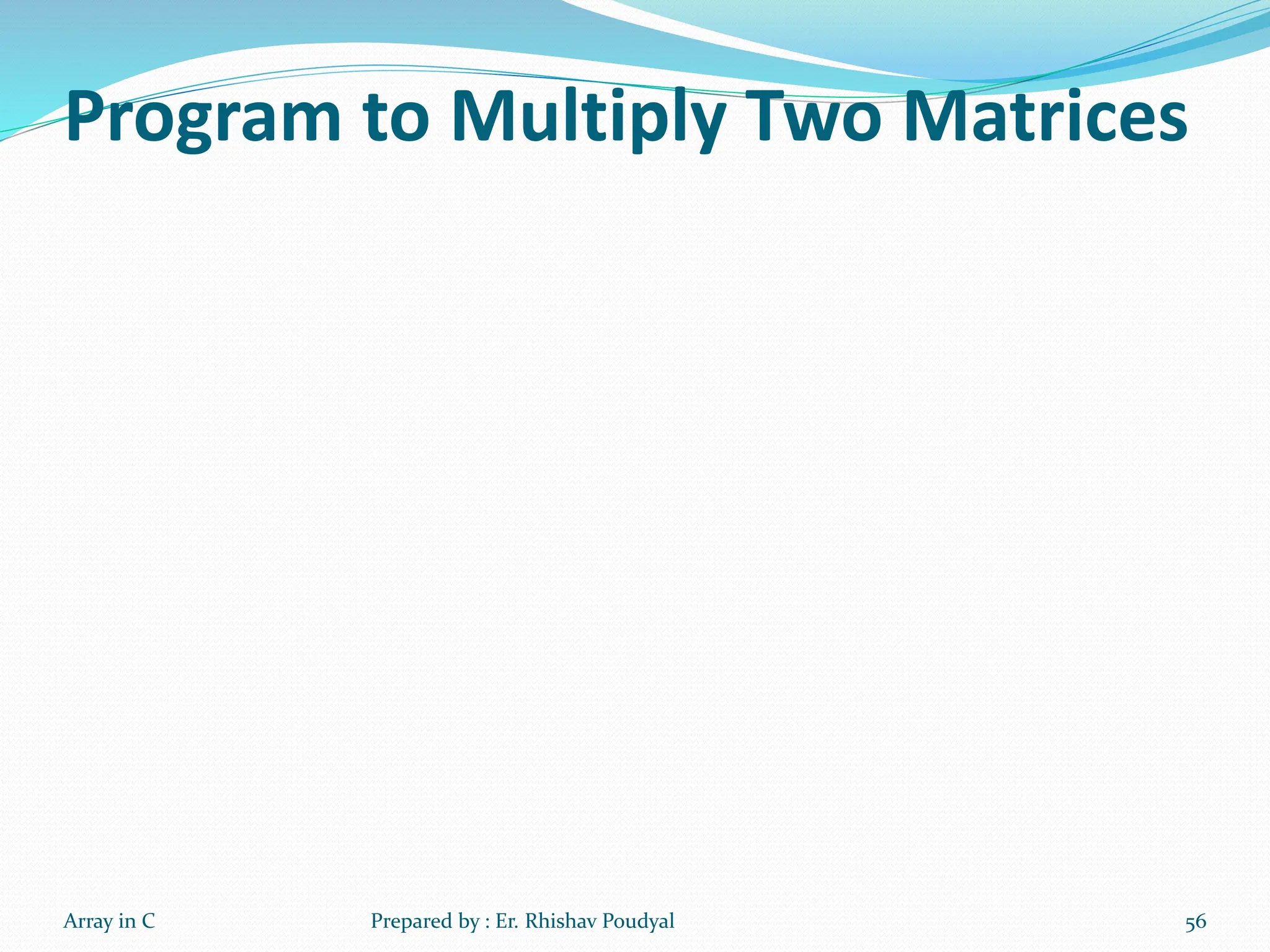
![57 #include <stdio.h> int main() { int a[10][10], b[10][10], result[10][10], r1, c1, r2, c2, i, j, k; printf("Enter rows and column for first matrix: "); scanf("%d %d", &r1, &c1); printf("Enter rows and column for second matrix: "); scanf("%d %d",&r2, &c2); // Column of first matrix should be equal to row of second matrix and if (c1 != r2) { printf("Error! column of first matrix not equal to row of second.nn"); } Array in C Prepared by : Er. Rhishav Poudyal](https://image.slidesharecdn.com/array-240708092845-bdb87368/75/Array-and-its-operation-in-C-programming-57-2048.jpg)
![58 // elements of first matrix. printf("nEnter elements of matrix 1:n"); for(i=0; i<r1; ++i) for(j=0; j<c1; ++j) { printf("Enter elements a%d%d: ",i+1, j+1); scanf("%d", &a[i][j]); } // elements of second matrix. printf("nEnter elements of matrix 2:n"); for(i=0; i<r2; ++i) for(j=0; j<c2; ++j) { printf("Enter elements b%d%d: ",i+1, j+1); scanf("%d",&b[i][j]); } Array in C Prepared by : Er. Rhishav Poudyal](https://image.slidesharecdn.com/array-240708092845-bdb87368/75/Array-and-its-operation-in-C-programming-58-2048.jpg)
![59 // Initializing all elements of result matrix to 0 for(i=0; i<r1; ++i) for(j=0; j<c2; ++j) { result[i][j] = 0; } // Multiplying matrices a and b and // storing result in result matrix for(i=0; i<r1; ++i) for(j=0; j<c2; ++j) for(k=0; k<c1; ++k) { result[i][j]+=a[i][k]*b[k][j]; } Array in C Prepared by : Er. Rhishav Poudyal](https://image.slidesharecdn.com/array-240708092845-bdb87368/75/Array-and-its-operation-in-C-programming-59-2048.jpg)
![60 // Displaying the result printf("nOutput Matrix:n"); for(i=0; i<r1; ++i) for(j=0; j<c2; ++j) { printf("%d ", result[i][j]); if(j == c2-1) printf("nn"); } return 0; } Array in C Prepared by : Er. Rhishav Poudyal](https://image.slidesharecdn.com/array-240708092845-bdb87368/75/Array-and-its-operation-in-C-programming-60-2048.jpg)